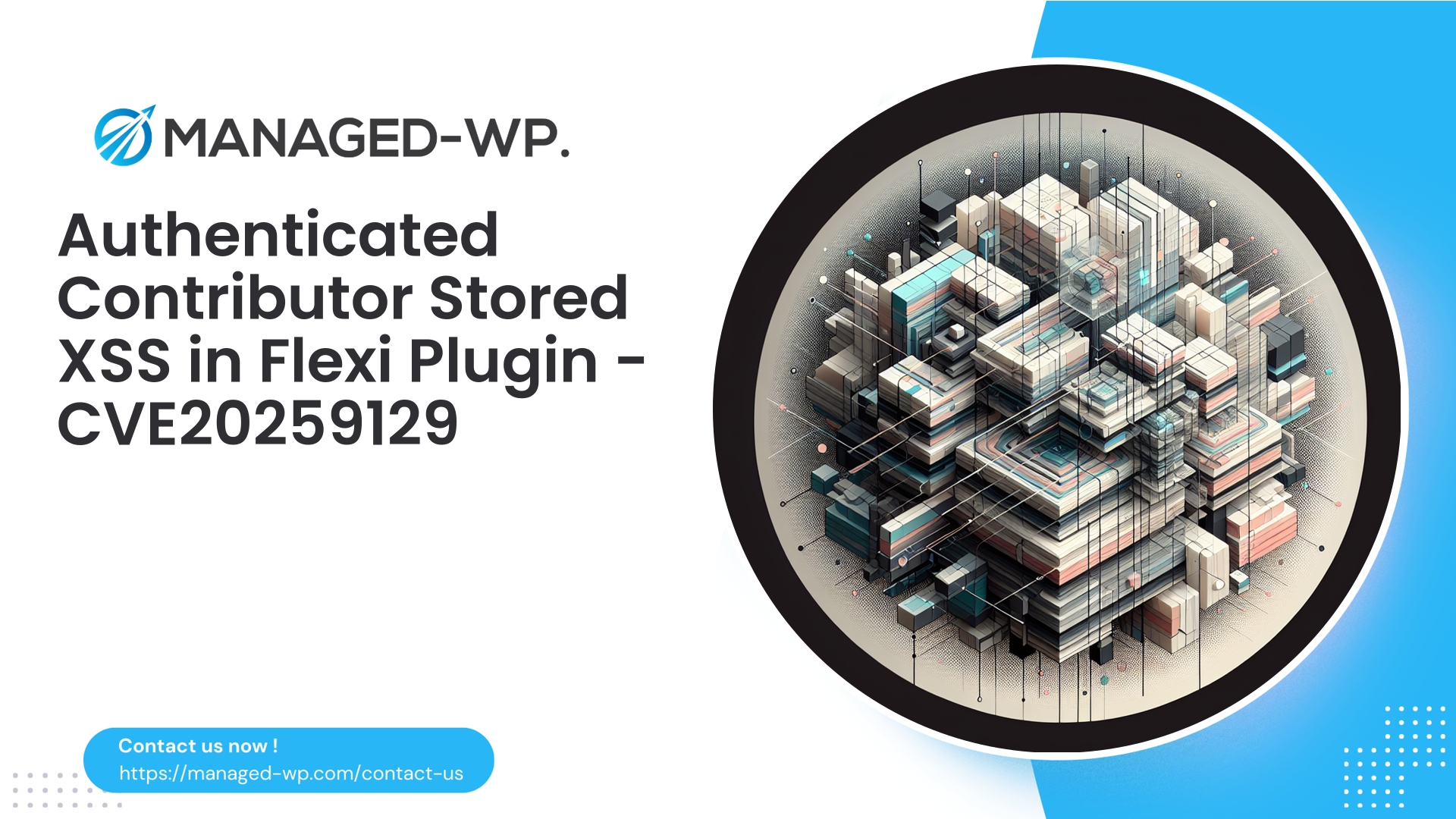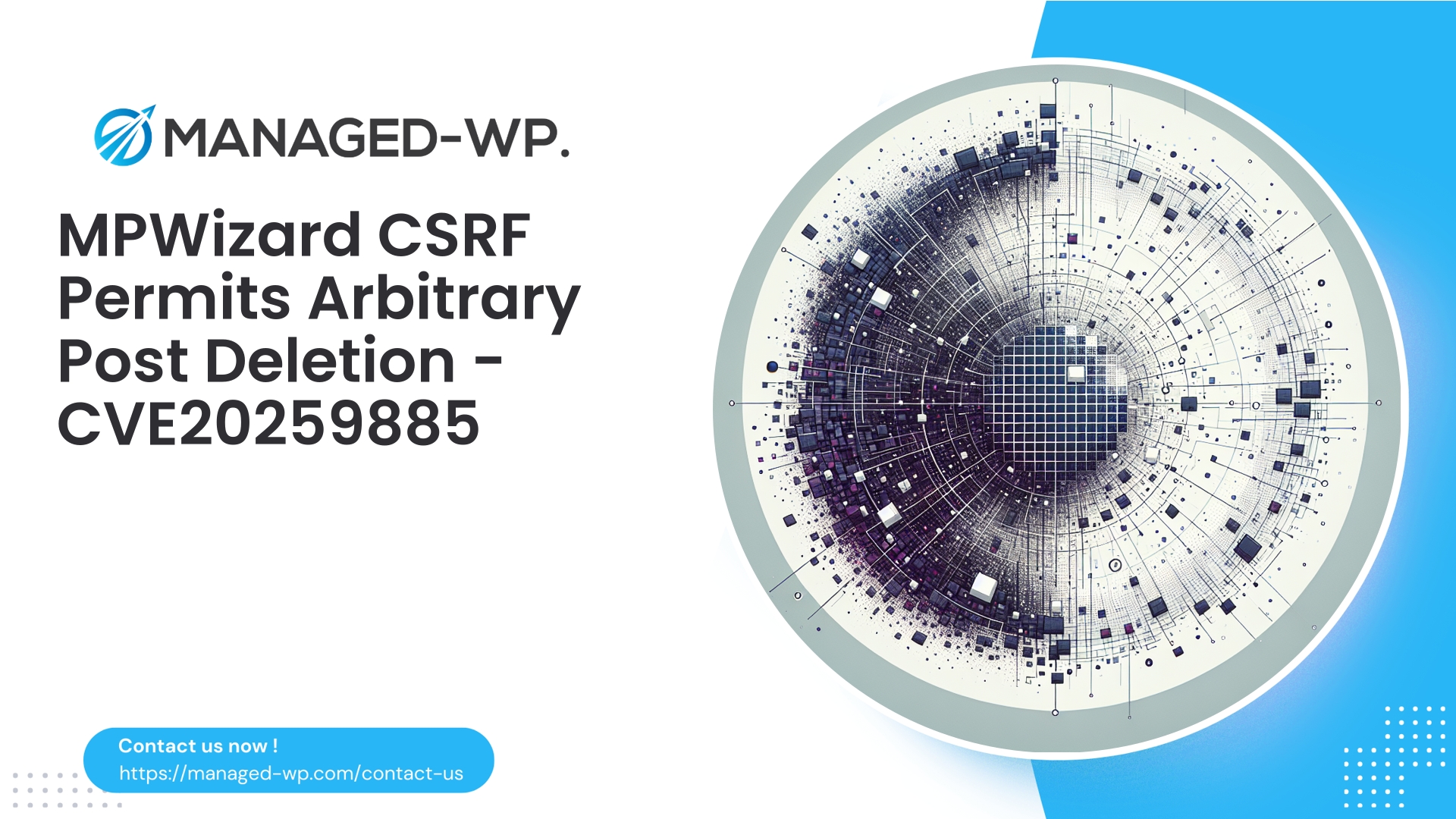| 插件名稱 | Flexi – 訪客提交 |
|---|---|
| 漏洞類型 | 儲存型跨站腳本攻擊(儲存型 XSS) |
| CVE編號 | CVE-2025-9129 |
| 緊急 | 低的 |
| CVE 發布日期 | 2025-10-03 |
| 來源網址 | CVE-2025-9129 |
緊急安全警報:Flexi – 訪客提交 (≤ 4.28) — 已認證貢獻者儲存型 XSS 漏洞 (CVE-2025-9129)
作者: 託管 WordPress 安全團隊
發布日期: 2025年10月3日
嚴重程度: CVSS 6.5(中等優先級)
CVE: CVE-2025-9129
執行摘要
- WordPress 外掛程式「Flexi – Guest Submit」4.28 及更早版本中發現了一個持久性跨站腳本(儲存型 XSS)漏洞。該漏洞允許具有“貢獻者”或更高權限的已認證用戶通過插件的短代碼處理程序(flexi-form-tag)注入惡意腳本有效載荷,這些有效載荷隨後會被存儲並提供給其他用戶或管理員,從而可能在內容渲染過程中被利用。
- 對於允許使用者從不太受信任的角色註冊或貢獻內容的網站來說,鑑於所需的貢獻者存取權限,這種漏洞尤其令人擔憂。
- 截至本文發佈時,尚未有官方補丁可用。 Managed-WP 強烈建議立即採取緩解措施並部署虛擬補丁,以降低風險,直到供應商發布正式更新為止。
本公告詳細分析了漏洞機制、潛在後果,並為網站所有者提供了切實可行的建議,同時也為插件維護者提供了最佳開發實務。此外,公告還概述了 Managed-WP 如何透過主動虛擬修補程式和防火牆措施來保護客戶。
了解漏洞
此漏洞為儲存型跨站腳本 (XSS) 漏洞。擁有貢獻者權限的攻擊者可以建構短代碼輸入,外掛程式會將這些未經清理的程式碼儲存到資料庫中。當這些惡意內容顯示給訪客或管理員時,嵌入的 JavaScript 程式碼就會執行,這可能會導致會話或帳戶外洩。
儲存型 XSS 會帶來嚴重風險,因為注入的有效載荷會在會話之間持續存在,並可能影響多個用戶,從而可能允許攻擊者劫持帳戶、竊取 cookie 或進一步操縱網站內容。
技術概述
註:為秉持負責任的揭露原則,本文省略了漏洞利用細節和具體酬載。本節重點在於攻擊途徑和指標。
- 攻擊面: 插件的 flexi-form-tag 處理功能會處理短代碼屬性、表單欄位和類似輸入,並將這些內容儲存在資料庫中。
- 入口點: 已認證的貢獻者級用戶可以透過貼文內容、評論或表單提交精心製作的內容。
- 脆弱行為: 該插件將未經清理的使用者資料輸出到渲染後的頁面中,從而可以執行嵌入式 JavaScript。
- 結果: 腳本以網域權限執行,可能會影響訪客、編輯和管理員。
允許使用者註冊或投稿者提交內容的網站風險最大。
貢獻者權限的重要性
WordPress 為使用者角色定義了特定的權限。貢獻者通常可以:
- 他們可以創建和編輯自己的帖子,但沒有發布權限。
- 提交內容以供編輯審核。
由於貢獻者可以創建公開可見或出現在管理佇列中的內容,因此在接受未經身份驗證的註冊或具有貢獻者權限的外部提交的環境中,利用此漏洞是可行的。
即使您的網站限制用戶註冊,仍然可以透過建立貢獻者等級帳戶的第三方外掛程式或主題獲得曝光。
剝削風險和潛在影響
一次成功的攻擊可能導致:
- 透過竊取 cookie 或 CSRF 令牌進行會話劫持和帳戶接管。
- 持續篡改網站,注入惡意HTML程式碼或虛假資訊。
- 重定向到攻擊者控制的網域或強制下載惡意軟體。
- 當儲存的有效負載在特權頁面上呈現時,透過 AJAX 呼叫執行未經授權的管理員操作。
- 垃圾郵件和惡意重定向會導致長期搜尋引擎優化受損和網域名稱被列入黑名單。
嚴重程度取決於儲存的有效載荷渲染位置以及對該內容公開的使用者權限等級。
入侵指標(IoC)
密切注意此漏洞是否已被利用的跡象:
- 意外的嵌入式腳本或 HTML 事件處理程序(以「.」開頭的屬性)
在*)在貼文、短代碼參數或自訂欄位中。 - 來自顯示已儲存使用者內容的頁面的可疑出站請求。
- 查看內容或貼文預覽時,管理員頁面出現異常行為。
- 出現未經授權的管理員帳戶或無法解釋的網站選項修改。
- 伺服器日誌顯示,與 flexi 相關的表單提交中存在帶有異常 HTML 標籤或屬性的 POST 請求。
- 資料庫表中存在與貼文、元資料或外掛程式特定儲存相關的腳本或事件處理程式碼。
透過掃描查找腳本 <script, 錯誤=, onload=, 或者 javascript: 在儲存的內容中。請注意HTML標記的合法用途。
為場地所有者提供即時緩解措施
如果您的網站使用 Flexi – Guest Submit 4.28 及更早版本,請立即採取以下步驟:
- 限製或停用公開註冊:
- 盡可能暫時停用新用戶註冊功能。
- 或者,將新使用者的預設角色限制為訂閱者或同等等級。
- 強制執行內容審核:
- 投稿人提交的內容需要管理員或編輯批准。
- 如果可配置,則限制貢獻者可以使用的短代碼或表單。
- 移除或停用外掛程式:
- 如果可行,請停用並卸載 Flexi,直到官方發布安全性修補程式為止。
- 應用 Web 應用程式防火牆 (WAF) 保護:
- 啟用虛擬修補規則,阻止針對 flexi-form-tag 輸入的可疑有效載荷。即使上游插件沒有更新,Managed-WP 的防火牆也能提供這些保護。
- 清理現有內容:
- 審查並清理可能存在惡意內容的儲存貼文和表單數據,並在清理過程中停用對不受信任內容的短程式碼執行。
- 審核使用者角色和日誌:
- 檢查是否有未經授權的管理員帳戶和可疑的 POST 請求。
- 備份您的網站:
- 在進行清理作業之前,請先建立完整的網站備份(資料庫和檔案)。
- 監控插件更新:
- 請關注插件的儲存庫或官方管道,以獲取針對 CVE-2025-9129 的補丁版本,並及時應用。
Managed-WP 如何提供保護
在 Managed-WP,我們採用多層防禦方法來保護您的網站,直到官方補丁發佈為止:
- 託管虛擬補丁: 我們的 WAF 部署了偵測簽名,可以阻止包含已知針對 flexi-form-tag 輸入的漏洞利用模式的請求,例如不允許的
<script表單提交中的標籤或事件屬性。 - 行為異常及應對規則: 我們偵測可疑的用戶代理、異常的請求速率和特殊的參數名稱,以防止自動化或持續性攻擊。
- 警報和報告: 阻止可疑活動會觸發警報,以便管理員可以即時調查。
- 免費套餐的安全預設設定: 我們為所有使用者提供基本的 OWASP Top 10 防護,而進階方案則包括自動修補和進階緩解措施。
雖然虛擬修補程式是一種臨時防禦措施,而不是永久解決方案,但它是保護生產站點直到正式更新發布之前最有效的方法。
緩解此漏洞的概念性WAF規則
以下是WAF用於防禦Flexi等插件中儲存型XSS漏洞的範例策略:
- 參數篩選:
- 包含文字的區塊表單輸入
<script標籤、可疑事件屬性(on[az]+=), 或者javascript:URI。 - 維護白名單,避免封鎖合法的HTML內容。
- 包含文字的區塊表單輸入
- 上下文感知輸出限制:
- 除非要求來自受信任的 IP 位址,否則禁止在管理頁面上使用可執行腳本渲染儲存的內容。
- 速率限制和行為監控:
- 偵測並阻止疑似存在惡意攻擊行為的快速或重複提交。
- 請求來源驗證:
- 對相關表單提交強制執行 nonce 和 CSRF 檢查。
- 簽章匹配:
- 根據混淆或編碼的 JavaScript 有效載荷的已知模式進行攔截。
Managed-WP 會自動為客戶套用並調整這些簽名。自行管理的 WAF 使用者應採用保守的規則以減少誤報,並定期查看日誌。
檢測特徵和指標(非漏洞利用範例)
若要新增檢測功能,請尋找:
- 存在
<script或者POST 資料中的標籤。 - HTML事件屬性模式,例如
on[az]+\s*=(不區分大小寫) - 採用 、 或類似百分比編碼方式編碼的有效負載,此處指涉腳本標籤。.
- 表單值中嵌入的 JavaScript URI 方案。
- 表單參數中包含異常長的字串或 base64 編碼的字串。
嚴格封鎖可能會對合法內容產生負面影響,因此初始部署應專注於日誌記錄和仔細調整,然後再全面強制執行。
面向插件開發者的安全編碼建議
維護插件安全需要嚴格處理使用者輸入和輸出:
- 永遠不要相信使用者輸入:
- 輸入資料時進行資料清理,輸出時進行正確的轉義。
- 使用合適的 WordPress 函數:
- 使用以下方法對輸入內容進行消毒:
sanitize_text_field()對於純文本,或wp_kses()/wp_kses_post()用於受控 HTML。 - 轉義輸出
esc_html(),esc_attr(), 或者wp_kses_post()根據上下文而定。 - 避免
do_shortcode()基於未經核實或不可信的數據。
- 使用以下方法對輸入內容進行消毒:
- 限制只有受信任的使用者才能保存原始 HTML 程式碼:
- 在允許提交原始標記之前,必須強制進行能力檢查。
- 伺服器端移除危險標籤和屬性。
- 實現能力和隨機數驗證:
- 使用安全端點
當前使用者可以()以及 nonce 保護。
- 使用安全端點
- 上下文感知轉義:
- 將轉義函數與輸出上下文(HTML 正文、屬性、JavaScript 上下文)相符。
- 安全的預設設定和明確的選擇加入:
- 預設輸出已清理過的輸出;僅允許對明確信任的角色輸出原始 HTML。
- 測試與分析:
- 整合自動化測試以檢測不安全的腳本注入。
- 利用模糊測試和靜態分析來發現安全漏洞。
插件維護者應優先發布包含這些原則的補丁,並更新所有受支援的版本以緩解 CVE-2025-9129。
範例安全編碼片段(非漏洞利用程式碼):
。 ?? '' ), $allowed_tags ); // 在輸入屬性中安全輸出 echo ' '; ?>
洩漏後清理程序
如果確定漏洞已被利用,請依下列步驟操作:
- 遏制:
- 停用存在漏洞的外掛程式或將網站置於維護模式。
- 暫時停用用戶註冊功能。
- 強制所有管理者和編輯重置密碼。
- 調查和清除:
- 掃描並清理資料庫,尋找可疑腳本或事件屬性。
- 目標文章、自訂文章類型、文章元資料、選項和外掛程式特定表格。
- 恢復:
- 如有需要,請從已知的乾淨備份中還原。
- 會話和金鑰撤銷:
- 使活動會話失效,輪換 API 金鑰,並重置鹽值。
- 持續監測:
- 清理後,密切注意日誌和 WAF 警報,以發現可疑活動。
- 事件響應:
- 如果內部專業安保人員有限,可以考慮聘請專業的安保服務公司。
推薦的 WordPress 安全加固實踐
- 應用最小權限原則,僅授予受信任的使用者「貢獻者」或更高權限。
- 啟用對低權限使用者提交內容的審核工作流程。
- 盡量減少外掛和主題佔用空間,以減少攻擊面。
- 對具有較高權限的使用者強制執行多因素身份驗證 (MFA)。
- 定期進行備份和復原測試。
- 利用託管式 WAF 和安全監控服務,快速部署虛擬修補程式。
- 隨時關注 WordPress 安全公告、外掛程式更新日誌和 CVE 揭露資訊。
監測與記錄:需要追蹤的關鍵領域
- Web 伺服器存取和錯誤經驗,用於偵測異常 POST 請求或不尋常的 HTTP 狀態碼。
- WordPress偵錯日誌,尤其是在可疑上傳或內容變更之後。
- 防火牆日誌顯示相關表單端點上的封鎖或可疑活動。
- 管理活動日誌,用於記錄意外的使用者建立或權限變更。
- 出站流量警報表示可能存在資料外洩或惡意重定向。
資訊揭露時間表和負責任的報告
- 該漏洞於 2025 年 10 月 3 日公開揭露,並被分配了 CVE-2025-9129。
- 發布此公告時,尚未有官方供應商補丁可用。 Managed-WP 敦促外掛程式作者優先發布修復程序,並清楚告知受影響的版本和補丁。
Managed-WP 保持警惕,並隨著新資訊的出現繼續部署虛擬補丁,以保護我們的客戶。
建議摘要
如果您的網站運行的是 Flexi – Guest Submit 版本 4.28 或更低版本,您應該:
- 透過停用公開註冊或限制貢獻者權限來降低風險,並加強審核。
- 暫時停用或移除該插件,直到廠商發布補丁為止。
- 立即透過虛擬補丁啟動WAF保護。
- 嚴格審核並清理儲存的內容。
- 輪換憑證,審查使用者帳戶,並仔細檢查日誌。
- 官方安全補丁發布後應立即套用。
使用 Managed-WP Basic 立即獲得保護 — 免費防火牆和安全服務
使用 Managed-WP Basic 即可立即保護您的 WordPress 網站——我們的免費套餐提供託管防火牆、無限頻寬、主動維護的 Web 應用防火牆、惡意軟體掃描以及強大的 OWASP Top 10 風險緩解措施。這確保您無需等待插件更新即可抵禦儲存型 XSS 等常見漏洞。
為了獲得更強大的保護,請考慮我們的標準版和專業版套餐,其中包括自動清除惡意軟體、IP 黑名單、每月安全報告和即時虛擬修補程式等功能。
立即使用 Managed-WP Basic(免費)保護您的網站安全
計劃概述:
- 基礎版(免費): 託管防火牆、網路應用防火牆、惡意軟體掃描器、OWASP Top 10 漏洞覆蓋、無限頻寬。
- 標準($50/年): 新增自動惡意軟體清理、IP黑名單/白名單功能。
- 專業版($299/年): 新增每月安全報告、自動虛擬修補程式、進階安全性外掛程式和託管服務。
如需協助套用即時虛擬修補程式、調查可疑活動或設定防火牆規則,我們的 Managed-WP 安全團隊隨時為您提供支援。請透過您的 Managed-WP 控制面板聯絡我們,我們將為您提供專業的事件回應和優先處理服務。



















